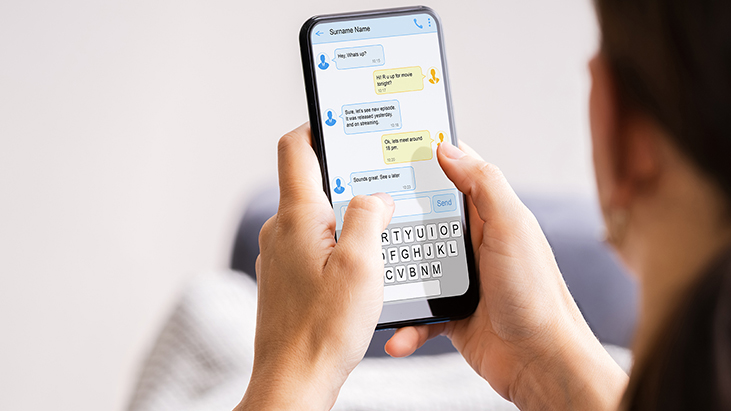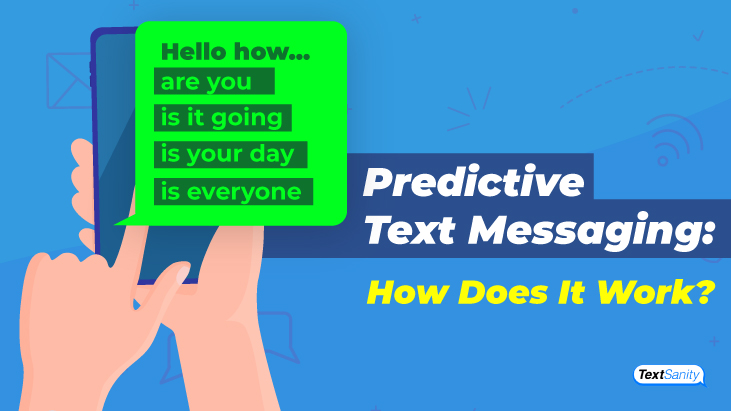Predictive Text Messaging: How Does It Work?
Predictive text messaging is a useful feature that you’ll find on any smart device, including smartphones, tablets, and many recent computers. In addition to making digital communication easier, this feature has applications in the world of business that you might not know about.
To be more specific, predictive text messaging is used in marketing and customer service. Here’s how it works and how you can use it for your business.
 Which algorithm is used for prediction?
Which algorithm is used for prediction?
The algorithm used for predictive text messaging depends on the operating system used or even the mobile application used.
As a result, Apple devices using an iOS operating system utilize a different algorithm than Samsung devices using an Android operating system. Social media apps like Facebook and Twitter also use different algorithms. You may have noticed some of these algorithms are more accurate than others.

 How does the predictive text algorithm work?
How does the predictive text algorithm work?
The predictive text algorithm is a fascinating piece of technology that analyzes words and sentence structures within a dataset using artificial intelligence. Theoretically, the more information the algorithm has to analyze, the more accurate its predictions are. However, in practice, that’s not necessarily the case.
For example, when iOS 13 was released in 2019, users found that the predictive text algorithm was too aggressive. It was taking information from apps and contact lists to build its base while also tainting it in the process. If a contact’s name was spelled or capitalized a certain way, the system would then assume that it should always be typed like that.
While this may seem easy enough to address, there were other issues that were more difficult to solve. For example, the algorithm would capitalize words seemingly at random. The opposite was also an issue wherein the algorithm would refuse to capitalize proper nouns that should be capitalized.
Thankfully, Apple’s system has since been upgraded, and some of these issues have been addressed; however, many still remain.
 How does the predictive text algorithm work? How is your “local dictionary” built?
How does the predictive text algorithm work? How is your “local dictionary” built?
Your local dictionary consists of words that you use on a regular basis. Each word is then scored based on the likelihood that you’ll use it again.
For example, if you type a word that’s not already in your local dictionary, it will likely assume that it’s a mistake and will offer alternative words. From there, you can either choose to accept the correction, ignore the suggestion, or add the word to your dictionary.
If you ignore the suggestion once, the word will be assigned a low score, assuming that it’s not used very frequently. However, the more you ignore the suggestion, the higher the word’s score will be, and the more often it will be suggested when typing.
One way to bypass the learning process is to manually add the word to your dictionary. The tool then learns what keys you press when you’re spelling that specific word and what words you prefer to use before and after the word so that it provides better suggestions.

 How does the predictive text algorithm work? How does a predictive keyboard work?
How does the predictive text algorithm work? How does a predictive keyboard work?
A predictive keyboard works by building your local dictionary and learning how you type. The more it learns, the more accurate predictions it makes and the better suggestions it provides.
So while it may be tempting to disable your predictive keyboard simply, first try it out and see if the accuracy improves the more you use it.
If it’s still too frustrating even after it’s learned how you type, then you can always disable it.

 Predicting customers texts using TextSanity
Predicting customers texts using TextSanity
There are other forms of predictive text messaging besides the iOS feature on your iPhone. Predictive text messaging can also be used to communicate quickly and effectively with customers. You will need to build a text message keyword tree to do this.
Build a text message keyword tree
A text message keyword tree allows you to use a chatbot to communicate with customers based on set prompts and responses. Start by creating an opt-in multiple message campaign in TextSanity where customers opt-in by responding with the keyword “YES.”
You then follow up with a question that asks them what they’re interested in. For example, if you own your own hair salon business, you might ask them what they need help with.
They could respond with “A” for more information about your services, “B” for more information about your stylists, or “C” for more information about your different locations.
Let’s say they respond with “A” for more information about your services. You could then set up a campaign where they can respond to specific keywords, for example, “hair cuts,” “hair color,” or “hairstyling.”
Suppose they respond with “B” for more information about your stylists. Your campaign could then ask them to respond with “D” for Dana, “E” for Elizabeth, or “F” for Fiona. From there, they are directed to each stylist’s personal scheduling or contact page.
Finally, they could respond with C” for more information about your different salon locations. By texting “Atlanta,” “Tampa,” or “Miami,” they could be provided the address for each location in addition to a link for a pinned map.

Ways to use predictive text messaging
This is just one example of how you can use predictive text messaging for your business. Here are some other ways that you can use predictive text messaging to communicate with your customers:
Use predictive text messaging to confirm orders and track shipping
Customers can opt-in to receive text messages about their recent order. When a customer makes a purchase, a confirmation text is sent to them with their order information. From there, they can respond to track their order, view order details, or ask questions about their order.
Use predictive text messaging to collect customer feedback
Customers can provide feedback about their experiences using predictive text messaging. After interacting with a customer, text them and ask if they’d be willing to complete a survey. If they are willing, ask several questions about their experience and rate certain aspects on a scale of one to ten.
Use predictive text messaging for customer service
Customers can quickly get answers to their questions with predictive text messaging. Start by sending them a list of common questions with a letter assigned to each one. Then provide them with the appropriate answer based on their response.
Use predictive text messaging to host contests
Engage your customers with fun contests using predictive text messaging. Have them send a text to opt-in and respond by asking them more questions or for more contact information. In exchange, you will enter them in a contest or giveaway.
Use predictive text messaging to help customers shop
Act as a personal shopper for your customers by using predictive text messaging. Customers can text you about different categories of items, and you can respond with recommendations, sizing, availability, pricing, etc.
Use predictive text messaging to educate customers on new products
Get the word out about new products with predictive text messaging. Have them text a keyword related to the product and then ask them a series of questions related to that product. For example, they could text the word “features” to learn about the product’s features or “options” to learn about different options.
Predictive text messaging best practices
The sky’s the limit with predictive text messaging, so get the most out of it by incorporating these best practices into your strategy:
- Don’t limit yourself: With TextSanity, there’s no limit to the number of keyword trees that you can create. Provide your customers with as much information and interaction as possible by setting up several keyword trees to cover all of their possible questions.
- Stay organized with tags: When you have several keyword trees going, it can be difficult to keep your information organized. Incorporate tags into your campaigns so that you can quickly and easily access the information you’re looking for.
- Harness your data: TextSanity also makes it easy for you to harness the data gathered from your predictive text messaging campaigns. For example, you can track the responses from customer satisfaction surveys to see how many customers are fully satisfied with their service compared to how many customers had complaints about their service.

Conclusion
When used correctly, predictive text messaging is an extremely valuable tool for any business that’s looking to provide its customers with a better overall experience.
Take advantage of predictive text messaging with TextSanity. To learn more and start building your own text message keyword trees, text the word “DEMO” to 50505.


